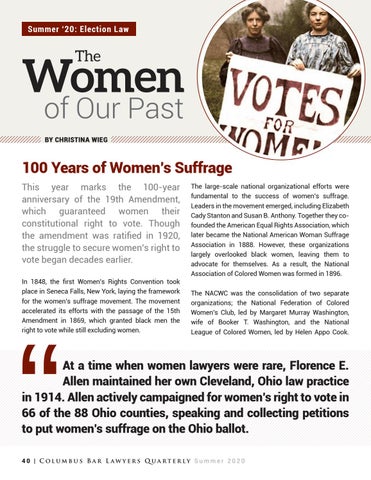Summer ‘20: Election Law
The
Women of Our Past BY CHRISTINA WIEG
100 Years of Women’s Suffrage This year marks the 100-year anniversary of the 19th Amendment, which guaranteed women their constitutional right to vote. Though the amendment was ratified in 1920, the struggle to secure women’s right to vote began decades earlier. In 1848, the first Women’s Rights Convention took place in Seneca Falls, New York, laying the framework for the women’s suffrage movement. The movement accelerated its efforts with the passage of the 15th Amendment in 1869, which granted black men the right to vote while still excluding women.
The large-scale national organizational efforts were fundamental to the success of women’s suffrage. Leaders in the movement emerged, including Elizabeth Cady Stanton and Susan B. Anthony. Together they cofounded the American Equal Rights Association, which later became the National American Woman Suffrage Association in 1888. However, these organizations largely overlooked black women, leaving them to advocate for themselves. As a result, the National Association of Colored Women was formed in 1896. The NACWC was the consolidation of two separate organizations; the National Federation of Colored Women’s Club, led by Margaret Murray Washington, wife of Booker T. Washington, and the National League of Colored Women, led by Helen Appo Cook.
At a time when women lawyers were rare, Florence E. Allen maintained her own Cleveland, Ohio law practice in 1914. Allen actively campaigned for women’s right to vote in 66 of the 88 Ohio counties, speaking and collecting petitions to put women’s suffrage on the Ohio ballot. 40 | Columbus Bar L aw yers Quarterly Summer 2020
